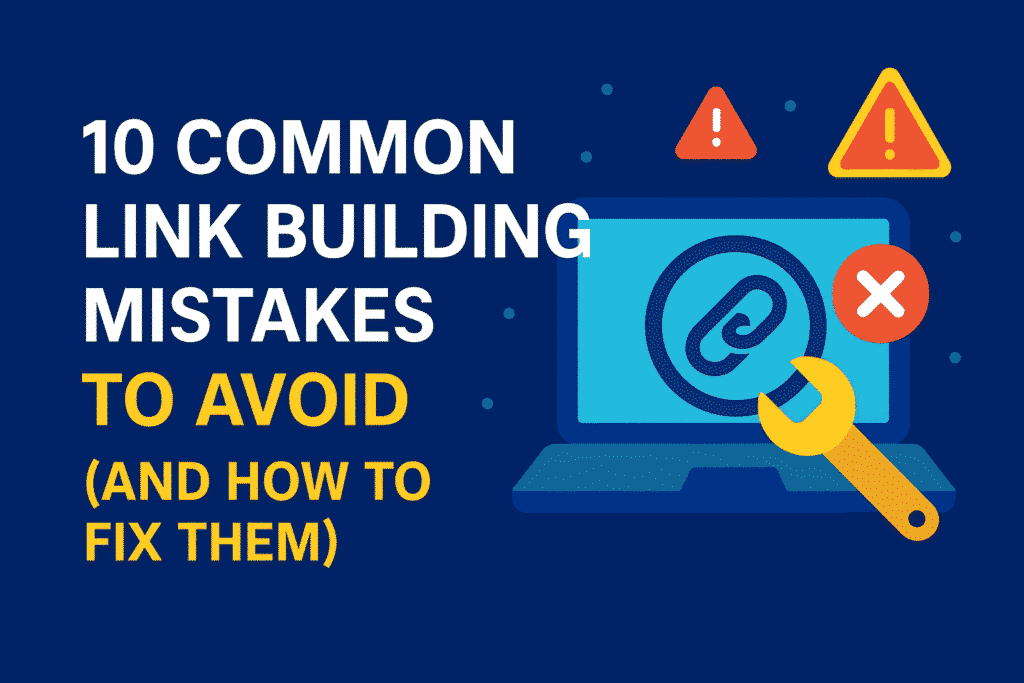
Contents
Linkbuilding remains one of the most critical aspects of SEO, directly influencing search engine rankings and organic traffic. However, many marketers and website owners unknowingly make mistakes that can hurt their SEO efforts rather than help them.
Google’s algorithms have evolved to prioritize quality over quantity, meaning outdated or spammy link-building tactics can lead to penalties, ranking drops, or even deindexing. To ensure your link-building strategy is effective and sustainable, you must avoid these 10 common mistakes—and learn how to fix them.
1. Ignoring Link Quality Over Quantity
The Mistake:
Some SEOs focus on acquiring as many backlinks as possible, regardless of their quality. They may use automated tools, spammy directories, or low-authority websites, thinking more links = better rankings.
Why It’s Harmful:
- Google penalizes poor-quality links (e.g., from PBNs, irrelevant sites).
- Low-authority links provide little to no SEO value.
- Excessive spammy links can trigger algorithmic filters (like Google Penguin).
The Fix:
- Prioritize high Domain Authority (DA) and Domain Rating (DR) sites (use tools like Ahrefs or Moz).
- Focus on relevant niches—links from industry-related sites carry more weight.
- Avoid link farms, automated link-building tools, and shady directories.
2. Buying Links or Using Black-Hat Tactics
The Mistake:
Some businesses resort to purchasing links or participating in link schemes (e.g., private blog networks, paid guest posts without disclosure).
Why It’s Harmful:
- Google explicitly forbids buying links (violates Webmaster Guidelines).
- Risk of manual penalties, leading to ranking losses.
- Short-term gains but long-term damage to site credibility.
The Fix:
- Build links organically through:
- Guest blogging (with genuine, high-quality contributions).
- Digital PR (earning media coverage through newsworthy content).
- Broken link building (replacing dead links with your content).
- If you must sponsor content, use
rel="sponsored"ornofollowtags for transparency.
3. Not Diversifying Anchor Text
The Mistake:
Overusing exact-match anchor text (e.g., “best SEO tools”) in backlinks looks unnatural and manipulative.
Why It’s Harmful:
- Google may flag it as over-optimization, leading to ranking suppression.
- A lack of variation makes your link profile appear spammy.
The Fix:
- Use a natural mix of:
- Branded anchors (e.g., “Linkerbuzz,” “Semrush”).
- Generic anchors (e.g., “click here,” “learn more”).
- Partial-match anchors (e.g., “effective SEO strategies”).
- Follow an 80/20 rule: 80% natural anchors, 20% keyword-rich.
4. Focusing Only on DoFollow Links
The Mistake:
Many SEOs ignore nofollow links (e.g., social media, forum links) because they don’t pass direct SEO value.
Why It’s Harmful:
- A natural backlink profile includes both dofollow and nofollow links.
- Google considers diversity in link types as a trust signal.
- Nofollow links still drive referral traffic and brand visibility.
The Fix:
- Pursue a balanced mix of:
- Dofollow links (from high-authority sites).
- Nofollow links (from Reddit, Quora, Wikipedia, social media).
- Sponsored/UGC tags where applicable.
5. Neglecting Internal Linking
The Mistake:
Websites often fail to link internally between related pages, missing out on SEO benefits.
Why It’s Harmful:
- Weak internal linking hurts crawlability and indexation.
- Missed opportunity to pass link equity to key pages.
The Fix:
- Link deep pages to cornerstone content.
- Use descriptive anchor text (avoid “click here”).
- Audit internal links using Screaming Frog or Sitebulb.
6. Skipping Link Reclamation
The Mistake:
Many marketers don’t reclaim broken or unlinked brand mentions, losing easy backlink opportunities.
The Fix:
- Use Google Alerts, Ahrefs, or Mention.com to find unlinked mentions.
- Politely email webmasters requesting a link.
- Fix broken backlinks by redirecting or suggesting replacements.
7. Overlooking Local SEO Link Building
The Mistake:
Businesses ignore local citations, directories, and partnerships, missing local search rankings.
The Fix:
- Get listed on Google Business Profile, Yelp, and niche directories.
- Partner with local influencers and bloggers.
8. Relying Only on One Link Building Method
The Mistake:
Depending solely on guest posts or directories limits growth.
The Fix:
- Diversify with:
- HARO (Help a Reporter Out) for media links.
- Skyscraper Technique (outreach to sites linking to competitors).
9. Not Tracking or Auditing Backlinks
The Mistake:
Failing to monitor backlinks leads to toxic links harming SEO.
The Fix:
- Use Ahrefs, SEMrush, or Google Search Console for audits.
- Disavow toxic links when necessary.
10. Failing to Build Relationships for Links
The Mistake:
Cold outreach without rapport leads to low response rates.
The Fix:
- Engage with industry influencers on social media.
- Offer value before asking for links (e.g., share their content).
To avoid spammy outreach, follow the templates in Link Building Outreach Emails That Get Replies.
Conclusion
Avoiding these 10 common link-building mistakes will help you build a strong, penalty-proof backlink profile that improves rankings sustainably. Focus on quality over quantity, diversify your strategies, and always audit your links to stay safe.
Ready to improve your link-building strategy? Build a proper plan using The Best Link Building Strategies That Actually Work in 2025.
